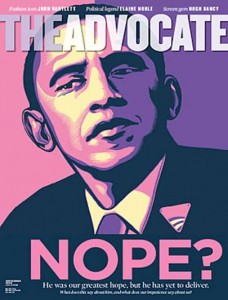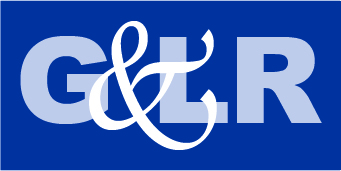At various points in 2009—during gay pride month in June, at the October 11th march on Washington, among others—various media outlets eagerly reported criticism of President Obama by some gay leaders. The September 2009 Advocate ran on its cover a campaign image of a despondent looking Obama; in place of the word “Hope” was the question “Nope?”
 GLBT advocates are right to be disappointed by some of the new administration’s policies. The U.S. military continues to purge accused homosexuals under “Don’t ask, don’t tell,” ruining careers and lives. In June 2009, Obama’s Department of Justice issued an offensive memo in support of the anti-gay Defense of Marriage Act (which candidate Obama had denounced). In its defense of DOMA, the DOJ cited Connecticut’s refusal to recognize an incestuous marriage from Italy and claimed that “gay and lesbian couples suffer no greater interference with their ability to obtain recognition of their marriages” than other couples under the 1996 law.
GLBT advocates are right to be disappointed by some of the new administration’s policies. The U.S. military continues to purge accused homosexuals under “Don’t ask, don’t tell,” ruining careers and lives. In June 2009, Obama’s Department of Justice issued an offensive memo in support of the anti-gay Defense of Marriage Act (which candidate Obama had denounced). In its defense of DOMA, the DOJ cited Connecticut’s refusal to recognize an incestuous marriage from Italy and claimed that “gay and lesbian couples suffer no greater interference with their ability to obtain recognition of their marriages” than other couples under the 1996 law.
There has been significant progress on gay rights issues in the first year of progressive executive and legislative branch leadership, though perhaps not the dam-burst of dreams that we had hoped for. However, on another issue of critical concern to gay and bisexual men and transgender women, HIV/AIDS policy, the first year of Obama-Pelosi-Reid has been one of incredible breakthroughs.
Remember Jesse Helms? Among the huge accomplishments of 2009 is the repeal of two of the anti-gay North Carolina senator’s policies: the ban on HIV-positive individuals entering the U.S., and the ban on the use of funds for syringe exchange. Both policies date to the late 1980’s, when Helms, Congressman William Dannemeyer, and others took to the floor of Congress to whip up anti-gay AIDS hysteria.
The HIV entry ban prevented anyone with HIV from entering the U.S. for any reason. While waivers were granted to opposite sex spouses of U.S. citizens, they were not granted to same-sex partners, so the burden of this policy fell disproportionately on gay men. The ban undermined public health by forcing HIV-positive visitors who risked entry to leave their medications at home. It also prevented many who were already here from getting tested, diagnosed, and treated, thereby exacerbating the epidemic. (In New York City, immigrants are one third more likely than native born New Yorkers to be diagnosed with both HIV and AIDS, meaning they are being diagnosed a decade or more after getting infected.) The U.S. was one of only a dozen countries left with such a policy, alongside human rights-challenged nations like Sudan, Yemen, Singapore, and Egypt. President Obama signed the repeal of the 1987 HIV entry ban into law in October 2009, fulfilling a campaign promise.
Also in late 2009, Obama signed into law a repeal of the ban on using federal funds for syringe exchange.More than a third of AIDS cases in the U.S. are directly or indirectly associated with injection drug use, and more than a quarter million Americans have died from AIDS they contracted through sharing needles. Since the 1980’s, syringe exchange programs have proliferated at the local level. In New York state, the number of new infections among injection drug users dropped by nearly eighty percent from 1990 to 2002, thanks to the expansion of syringe exchange. Until now, due to the ban put in place by Senator Helms in 1988, the 185 syringe exchange programs in the U.S. have not been able to use federal funds to support their work. Given the current fiscal crisis, with local and state governments slashing public health and other social spending, syringe exchange programs need access to federal funds now more than ever. The repeal of the ban on the use of federal funds for syringe exchange will help this highly effective intervention to continue.
Another bright spot has been the de-funding of abstinence-only sex education programs in the schools. Since the Reagan years, the federal government has spent more than $1.5 billion on this approach. Repeated government-funded studies have shown that abstinence-only does not reduce teen sexual activity, pregnancy, or the spread of STDs. Worse, abstinence-only programs promote sexist gender stereotypes, spread dangerous misinformation about the efficacy of contraception and HIV prevention, and demonstrate pervasive anti-gay bias and ignorance about people living with AIDS.As such, they are not only ineffective and a waste of public dollars; they are also harmful to young people. Still, de-funding these programs was a tough move politically, since this is a longtime pet project of the religious right. Yet in December 2009, Obama signed into law a spending bill that completely eliminated funding for abstinence-only for the first time in nearly three decades—a huge accomplishment.
Another achievement under Obama is the reinvigoration of the Office of National AIDS Policy (ONAP).While Bush’s global AIDS relief program, launched in 2003, was a major accomplishment in HIV care, domestically Bush largely ignored the epidemic. Indicative of this was the fact that from 2006 through the end of his presidency, no one ran ONAP and it was largely defunct. Even when the office was staffed, Bush’s directors were not allowed to accomplish much in terms of innovative domestic policy approaches. By contrast, Obama’s ONAP has been hyperactive ever since openly gay health policy wonk Jeffrey Crowley was appointed director in February 2009. The top priority has been the development of a national HIV/AIDS strategy that sets specific, measurable goals to reduce new infections, increase access to care, and reduce health disparities, particularly those affecting African Americans (half of new infections) and gay men (more than half of new infections). ONAP held fifteen community meetings across the U.S. to inform a strategy and is now convening an interagency working group comprised, not only of the traditional HIV agencies, but also the Administration on Aging, Veteran’s Affairs, Department of Education, and other agencies.
Finally, there’s been a dramatic increase in the government’s international focus on men who have sex with men (MSM) through the President’s Emergency Plan for AIDS Relief (PEPFAR). In 2008, then Senator Biden sponsored and President Bush supported provisions calling for prevention and research targeting MSM in the reauthorization of PEPFAR. Global AIDS activists report a huge difference between doing MSM work last year compared with 2007. For example, the 2009 HIV Implementers’ Meeting—a gathering of PEPFAR grantees held in Namibia—included for the first time a workshop focused solely on prevention with MSM. This emphasis on MSM is due in part to the hard work of mid-level allies inside the U.S. Agency for International Development, the State Department, and elsewhere, but it’s also due to leadership at the top—that of Secretary of State Clinton, PEPFAR Ambassador Eric Goosby, UN Ambassador Susan Rice, as well as Obama and Biden. On World AIDS Day 2009, referring to the proposed Ugandan death penalty for homosexuals, Clinton said at a White House briefing:
- Our efforts are hampered whenever discrimination or marginalization of certain populations results in less effective outreach and treatment. So we will work not only to ensure access for all who need it, but also to combat discrimination more broadly. We have to stand against any efforts to marginalize and criminalize and penalize members of the GLBT community worldwide. It is an unacceptable step backwards on behalf of human rights. But it is also a step that undermines the effectiveness of efforts to fight the disease worldwide.
Since Clinton’s denunciation, the sponsor of the anti-gay bill in the Ugandan parliament has replaced the death penalty with life imprisonment for homosexuals, and the Ugandan government is under increasing pressure to kill the bill altogether.
Two decades ago, the U.S. gay rights movement and AIDS movement were inextricably entwined, in part due to the disproportionate impact of HIV on gay men, in part due to the way antigay politicians and activists exploited irrational fears about AIDS to launch political attacks on gay men and lesbians. There was a movement in the late 80’s and early 90’s to decouple “gay” and “AIDS,” because this association was being used as a cudgel to attack both gays and PWAs. While this movement was somewhat successful, gay men are still disproportionately impacted by the disease, at least in the U.S. MSM comprised some 57 percent of new HIV infections in the U.S. in 2006, according to the Centers for Disease Control and Prevention. Black gay men are at the epicenter of the epidemic, accounting for one in five new infections. Trans women are also disproportionately affected by HIV, although we don’t have as good data for them.
In the first year of the Obama presidency and the Pelosi-Reid Congress, we have repealed a quarter century’s worth of bad public policies on HIV/AIDS and launched initiatives with great potential to fight the epidemic more effectively. The gay community should factor this into its judgment of what President Obama has done for us thus far.
Sean Cahill works for Gay Men’s Health Crisis in New York.




